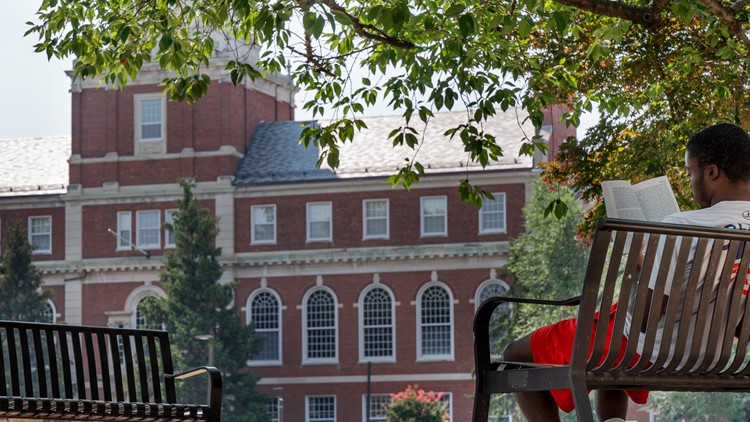UPDATE (6/30/23): The Supreme Court has struck down the Biden administration's one-time student loan forgiveness plan. Loan repayments are expected to resume later this summer. You can read more information here.
On Aug. 24, the Biden administration announced it was planning to forgive some federal student loan debt. The Department of Education is set to forgive up to $10,000 for many students, and up to $20,000 for students who received Pell Grants while in school, if they meet income qualifications.
Since then, several readers have reached out to VERIFY with questions about how graduate loans factor into this decision. We answer the most common forgiveness questions about graduate loans.
THE SOURCES
- White House
- U.S. Department of Education
- Betsy Mayotte, president of The Institute of Student Loan Advisors (TISLA)
- Jessica Thompson, vice president of The Institute for College Access & Success (TICAS)
- Miguel Cardona, U.S. Secretary of Education
- A Department of Education spokesperson
QUESTION #1
Are graduate loans included in the student debt forgiveness plan?
THE ANSWER
Yes, graduate loans are included in the student debt forgiveness plan.
WHAT WE FOUND
Debt accrued from graduate loans is eligible for forgiveness, so long as it’s a federal loan held by the Department of Education.
Secretary of Education Miguel Cardona tweeted that all loans held by the Department of Education are eligible for forgiveness. That includes graduate loans — as well as Grad PLUS loans, Parent PLUS loans and spousal loans.
“We were worried they were going to exclude grad, or Parent PLUS, or both,” said Betsy Mayotte, president of The Institute of Student Loan Advisors (TISLA). “And they are absolutely not excluded. They are just as eligible for this forgiveness.”
Other student loan experts echoed Mayotte’s reassurances.
“We have confirmed that graduate student borrowers will be included in this cancellation,” said Jessica Thompson, vice president of The Institute for College Access & Success (TICAS). “So again: same income thresholds, same amounts.”
More from VERIFY: Yes, eligible public service workers can still get full federal student loan forgiveness
QUESTION #2
Can student borrowers receive $20,000 in forgiveness on graduate loans if they received Pell Grants as undergraduate students?
THE ANSWER
Yes, student borrowers can receive $20,000 in forgiveness on graduate loans if they received Pell Grants as undergraduate students.
WHAT WE FOUND
Students qualify for up to $20,000 in federal student debt forgiveness on any federal student loans if they received a Pell Grant.
Pell Grants are typically only awarded to “undergraduate students who display exceptional financial need and have not earned a bachelor's, graduate or professional degree,” the U.S. Department of Education says.
But some students may have received a Pell Grant as an undergraduate, and gone on to accrue federal loan debt from graduate school. The White House’s forgiveness plan stipulates that such a person would qualify for $20,000 in debt forgiveness, even if the outstanding loans are only graduate school loans.
Not once does the White House or Department of Education specify that the extra forgiveness for Pell Grant recipients is exclusive to undergraduate loans. A graphic tweeted by Biden when he first announced the plan says that his administration’s plan forgives $20,000 in debt “if you went to college on Pell Grants.”
“Think of the Pell Grant receipt as an eligibility criteria determining the amount you can have canceled against your total outstanding qualifying (e.g. federally held) debt,” said Jessica Thompson, vice president of TICAS.
People enrolled in post-baccalaureate teacher certification programs are also eligible for Pell Grants, and if they received a Pell Grant while in these programs, they are also eligible for $20,000 in forgiveness.
More from VERIFY: Yes, Parent PLUS loans are eligible for debt forgiveness
QUESTION #3
Do the changes to income-driven repayment plans apply to graduate loans?
THE ANSWER
Some of the changes to income-driven repayment plans apply to graduate loans, but not all.
WHAT WE FOUND
The changes to income-driven repayment plans as described by the White House focus on tackling how much a student borrower has to pay each month, how long it takes loan balances to be forgiven for people on these plans and how much interest can accrue for borrowers on these plans.
Some of these changes apply exclusively to undergraduate loans, while other changes include graduate loans and undergraduate loans.
IDR plan income caps
Income-driven repayment plans for undergraduate loans will now be capped at 5% of a borrower’s discretionary income — that’s a person’s income after taxes and necessities — which is half of the 10% cap it is currently.
Income-driven repayment plans for graduate loans will be capped at 10%, which is not a change from the most recent existing policy, although some older plans capped graduate loan repayment at 15% or 20% of discretionary income.
People with both undergraduate and graduate loans will not have to make two separate payments, however. The Department of Education said “borrowers with both undergraduate and graduate loans will pay a weighted average rate.” That means that people with both types of loans on income-driven repayment plans would pay at a rate between 5% and 10%, based on how much they owe in undergraduate versus graduate school loans.
Income exclusion
The proposed rule would also raise the amount of income someone needs to make before they are required to make monthly payments from 150% of the federal poverty level to 225% of the federal poverty level, which the White House says is about the annual equivalent of a $15 hourly wage. Borrowers with both undergraduate and graduate loans will not have to make monthly payments through these plans if they make less than that amount, so long as they apply for the income-driven repayment plan.
Unpaid monthly interest
The Department of Education is also proposing that it will cover the borrower’s unpaid monthly interest through its new income-driven repayment plans, making it so no borrower’s balance will grow as long as they make their monthly payments, even if that monthly payment is $0.
Jessica Thompson, the vice president of TICAS, said that her organization’s current understanding is that this is inclusive of all borrowers enrolled in this new plan, including borrowers with graduate loans. But she said this will be important to confirm upon the release of additional detail from the Department of Education.
Loan forgiveness after 10 years
The last major facet of this proposed plan is that it would forgive loan balances after 10 years of repayments, instead of the 20 years it is currently, for borrowers with original balances of $12,000 or less.
“Our current understanding is that the $12k amount is not required to be undergraduate or graduate debt, but that the requirement is that you did not take out more than $12k in total (total principal amount borrowed),” Thompson said. “So, in reality, this will apply to very few graduate students, who tend to borrow much higher amounts than $12k. Just to emphasize, this is not about what your outstanding balance owed is at 10 years, but about the total amount of debt you borrowed/was disbursed to you originally.”
The Department of Education has not yet confirmed to VERIFY the details of this plan. How this impacts borrowers with graduate loans is subject to change based on information the Education Department releases.
In summary, here’s how each aspect of the income-driven repayment plan changes affects graduate borrowers
Graduate loan borrowers will not receive the cut in monthly payments from 10% of their discretionary income to 5%. Borrowers with both undergraduate and graduate loans will pay a weighted average rate between 5% and 10%.
Graduate loan borrowers will benefit from the increased income threshold before payments are required in income-driven repayment plans from 150% of the federal poverty level to 225% of the federal poverty level.
Graduate loan borrowers will likely have their unpaid monthly interest covered by the Department of Education so that their balances don’t grow. This is based on experts’ current understanding, and is awaiting confirmation by the Education Department.
Graduate loan borrowers will likely be included in the plan to forgive loans after 10 years of payments, although this will benefit very few people with graduate loans because they tend to borrow much higher amounts than $12,000, which is the cap for this. This is based on experts’ current understanding, and is awaiting confirmation by the Education Department.
CORRECTION (8/30/22): The original version of this story said Question #3 was false. This was based on the cut in the monthly payment discretionary income rate. The answer to this question has been updated to reflect that some aspects of this plan do include graduate loans.
More from VERIFY: Yes, there is a way to check if you received a Pell Grant



